Following rumours on high-end RDNA 5 GPUs, new leaks have come to light that potentially shed light on how AMD plans to offer the architecture to the mobile and low-end desktop markets. These proposed specifications highlight a significant change in approach to memory configuration but also the interchangeability of dies across form factors.
According to Moore’s Law Is Dead (MLID), AMD is working on at least five RDNA 5 GPU configurations. That’s in addition to AT0 and AT2, the high-end desktop dies the YouTuber shared earlier this year.
| AT3 | AT4 | |
|---|---|---|
| Compute units | 48 | 24 |
| Bus width | 384-bit (PCIe 5.0 x8) 256-bit (PCIe 5.0 x8) | 128-bit (PCIe 5.0 x8) |
| VRAM | LPDDR6 LPDDR5X | LPDDR5X |
On the desktop front, AMD has AT3 and AT4 up its sleeve. Both of these GPUs are considerably weaker than AT0 and AT2, with far fewer compute units but that’s not the most surprising part of their composition.
Turns out AMD plans to pair these lower-end RDNA 5 GPUs with LPPDR5X/LPDDR6 VRAM, rather than standard DDR modules. Such a move would improve power efficiency in the dies, but this is less of a concern for desktop cards.
Moore’s Law Is Dead posits that this choice of memory, paired with their bus widths, could afford AMD the ability to offer obscenely high VRAM capacities. This would benefit local AI performance more than gaming, but could nonetheless prove advantageous.
| MDSH | MDSH-M | MDS1 | |
|---|---|---|---|
| Cores | 24+0+2 | 4+8+2 | 16+4+2 |
| Compute units | 48 | 24 | 8 |
| Bus width | 384-bit (PCIe 5.0 x8) 256-bit (PCIe 5.0 x8) | 128-bit (PCIe 5.0 x8) | 128-bit (PCIe 5.0 x8) |
| VRAM | LPDDR6 LPDDR5X | LPDDR5X | LPDDR5X |
Shifting focus from desktop to mobile, Medusa Point APUs should pack a variety of Zen 6, Zen 6c, and Zen 6 LP cores, as per previous leaks. More interestingly, though, is how these chips’ integrated graphics mirror AT3 and AT4 exactly.
Moore’s Law Is Dead suggests this is because AMD will use GPU chiplets to outfit their APUs. This would allow Team Red to efficiently share GPUs between desktop and mobile, manufacturing fewer designs but with higher stock.
If these rumours hold water, I’m curious to see how much power both desktop and mobile variants of these GPUs will have. I don’t expect them to have the same budget at their disposal, which will in turn affect performance.
Shifting to LPDDR5X/LPDDR6 also presents challenges in terms of bandwidth, as these modules are significantly slower than their desktop counterparts. It could be that AMD plans to lean heavily on cache to make up the difference, but it’s impossible to know for sure at the moment.
Moore’s Law Is Dead is highly confident that MDS1 will be the first of this RDNA 5 batch to hit the market, in late 2026. Meanwhile, the rest will follow suit in 2027.
In the meantime, AMD is busy managing the rollout of the OEM-exclusive Radeon RX 9060. There’s no word on what the manufacturer has in store for the graphics market beyond that.
However, rumours of GeForce RTX 50 Super Series cards, launching later this year, could prompt AMD to respond with refreshes. Then there’s the matter of potentially more-powerful Battlemage Arc offerings emerging from Intel.
Whatever happens in the graphics market this year, Club386 will make sure to keep you in the know. Make sure you’re following the site on Google News for the latest updates.


